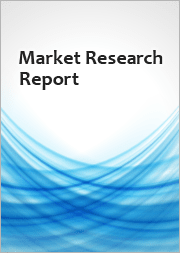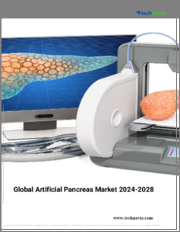
|
시장보고서
상품코드
1661011
세계의 인공 췌장 기기 시스템 시장 보고서 : 기기 유형별, 치료 유형별, 최종 사용자별, 지역별(2025-2033년)Artificial Pancreas Device Systems Market Report by Device Type, Treatment Type, End-User, and Region 2025-2033 |
||||||
세계의 인공 췌장 기기 시스템(APDS) 시장 규모는 2024년 25억 7,940만 달러에 달했습니다. 향후 IMARC Group은 시장이 2033년까지 60억 2,720만 달러에 달하고, 2025년부터 2033년까지 9.9%의 성장률(CAGR)을 나타낼 것으로 예측했습니다.
APDS는 인슐린 분비를 조절하여 혈당를 관리하는 폐쇄 루프 또는 자동 인슐린 분비 시스템을 말합니다. 연속 포도당 모니터(CGM), 피하 인슐린 주입 펌프, 모니터와 펌프를 연결하는 컨트롤러로 구성됩니다. 실시간 포도당 측정의 평가를 기반으로 인슐린의 적절한 수준과 투여 시간을 결정하는 복잡한 알고리즘을 수행합니다. 주로 신체의 포도당 수준이 극단적으로 변동하는 위험을 최소화하는 데 사용됩니다.
췌장암, 췌장염 및 기타 만성 질환의 유병률 증가는 시장 성장을 가속하는 주요 요인 중 하나입니다. 게다가 노화 관련 요인, 운동 부족, 건강에 해로운 식사 패턴에 의한 당뇨병과 비만의 발생이 증가하고 있는 것도 세계에서 APDS가 널리 채용되는 요인이 되고 있습니다. 효율적인 당뇨병 모니터링과 낮은 침습(MI) 약물 전달 시스템에 대한 수요 증가는 시장 성장에 탄력을 줍니다. APDS는 자동으로 포도당 수준을 모니터링하고 통제된 양의 인슐린을 하루 종일 투여합니다. 자동 제어와 통합된 소프트웨어 기반 무선 시스템 개발 등 다양한 기술 혁신이 시장 성장에 더욱 기여하고 있습니다. 또한 각국의 규제기관과 정부는 세계의 헬스케어 인프라를 개선하기 위한 연구개발(R&D)에 많은 투자를 하고 있습니다. 예를 들어, 미국 식품의약품협회(US FDA)는 혁신적인 신제품을 점차 승인하고 있으며, 이 나라 시장에 밝은 전망을 제공합니다.
이 보고서에서 다루는 주요 질문
- 세계 인공 췌장 기기 시스템 시장 시장은 지금까지 어떻게 추이해 왔는가?
- 주요 지역 시장은?
- COVID-19는 세계 인공 췌장 기기 시스템 시장에 어떤 영향을 미쳤는가?
- 기기 유형별 시장 분석은?
- 치료 유형별 시장 분석은?
- 최종 사용자별 시장 분석은?
- 업계의 밸류체인의 다양한 단계란?
- 업계의 주요 촉진요인과 도전은 무엇인가?
- 세계 인공 췌장 기기 시스템 시장의 구조와 주요 기업은?
- 업계 경쟁도는?
목차
제1장 서문
제2장 조사 범위와 조사 방법
- 조사의 목적
- 이해관계자
- 데이터 소스
- 1차 정보
- 2차 정보
- 시장 추정
- 상향식 접근
- 하향식 접근
- 조사 방법
제3장 주요 요약
제4장 소개
- 개요
- 주요 업계 동향
제5장 세계의 인공 췌장 기기 시스템 시장
- 시장 개요
- 시장 실적
- COVID-19의 영향
- 시장 예측
제6장 시장 내역: 기기 유형별
- 스레숄드 서스펜드 기기 시스템
- 시장 동향
- 시장 예측
- Control-to-Range 시스템
- 시장 동향
- 시장 예측
- Control-to-Target 시스템
- 시장 동향
- 시장 예측
제7장 시장 내역: 치료 유형별
- 바이호르몬
- 시장 동향
- 시장 예측
- 인슐린 전용
- 시장 동향
- 시장 예측
- 하이브리드
- 시장 동향
- 시장 예측
제8장 시장 분석 : 최종사용자별
- 병원
- 시장 동향
- 시장 예측
- 의료 센터
- 시장 동향
- 시장 예측
- 기타
- 시장 동향
- 시장 예측
제9장 시장 분석 : 지역별
- 북미
- 미국
- 캐나다
- 아시아태평양
- 중국
- 일본
- 인도
- 한국
- 호주
- 인도네시아
- 기타
- 유럽
- 독일
- 프랑스
- 영국
- 이탈리아
- 스페인
- 러시아
- 기타
- 라틴아메리카
- 브라질
- 멕시코
- 기타
- 중동 및 아프리카
- 시장 동향
- 시장 분석 : 국가별
- 시장 예측
제10장 SWOT 분석
- 개요
- 강점
- 약점
- 기회
- 위협
제11장 밸류체인 분석
제12장 Porter's Five Forces 분석
- 개요
- 구매자의 협상력
- 공급기업의 협상력
- 경쟁도
- 신규 진입업자의 위협
- 대체품의 위협
제13장 가격 지표
제14장 경쟁 구도
- 시장 구조
- 주요 기업
- 주요 기업 프로파일
- Beta Bionics Inc.
- Bigfoot Biomedical Inc.
- Dexcom Inc.
- Inreda Diabetic BV
- Insulet Corporation
- Johnson & Johnson
- Medtronic Inc.
- F. Hoffmann-La Roche Ltd
- Tandem Diabetes Care Inc.
The global artificial pancreas device systems (APDS) market size reached USD 2,579.4 Million in 2024. Looking forward, IMARC Group expects the market to reach USD 6,027.2 Million by 2033, exhibiting a growth rate (CAGR) of 9.9% during 2025-2033.
APDS refers to a closed-loop or automated insulin delivery system that manages blood glucose levels by regulating the production of insulin. It consists of a continuous glucose monitor (CGM), a subcutaneous insulin infusion pump and a controller that links the monitor with the pump. It runs a complex algorithm that determines the adequate levels of insulin and time of delivery based on the evaluation of real-time glucose readings. It is primarily used to minimize the risks of extreme fluctuations of glucose levels in the body.
The increasing prevalence of pancreatic cancer, pancreatitis and other chronic ailments is one of the key factors driving the growth of the market. Furthermore, the growing occurrence of diabetes and obesity, due to age-related factors, physical inactivity and unhealthy dietary patterns, is also contributing to the widespread adoption of APDS across the globe. The rising demand for efficient diabetes monitoring and minimally invasive (MI) drug delivery systems is also providing a boost to the market growth. APDS automatically monitors the glucose levels and administers doses of insulin throughout the day in controlled amounts. Various technological innovations, including the development of software-based wireless systems that are integrated with automated controls, are further contributing to the market growth. Moreover, regulatory bodies and governments of various nations are significantly investing in research and development (R&D) for the improvement of healthcare infrastructure across the globe. For instance, the Food and Drug Association (US FDA) in the United States is approving an increasing number of new and innovative products, which is creating a positive outlook for the market in the country.
Key Market Segmentation:
Breakup by Device Type:
- Threshold Suspend Device Systems
- Control-to-Range Systems
- Control-to-Target Systems
Breakup by Treatment Type:
- Bi-hormonal
- Insulin Only
- Hybrid
Breakup by End-User:
- Hospitals
- Medical Centres
- Others
Breakup by Region:
- North America
- United States
- Canada
- Asia Pacific
- China
- Japan
- India
- South Korea
- Australia
- Indonesia
- Others
- Europe
- Germany
- France
- United Kingdom
- Italy
- Spain
- Russia
- Others
- Latin America
- Brazil
- Mexico
- Others
- Middle East and Africa
Competitive Landscape:
The competitive landscape of the industry has also been examined with some of the key players being Beta Bionics Inc., Bigfoot Biomedical Inc., Dexcom Inc., Inreda Diabetic B.V., Insulet Corporation, Johnson & Johnson, Medtronic Inc., F. Hoffmann-La Roche Ltd, Tandem Diabetes Care Inc., etc.
Key Questions Answered in This Report:
- How has the global artificial pancreas device systems market performed so far and how will it perform in the coming years?
- What are the key regional markets?
- What has been the impact of COVID-19 on the global artificial pancreas device systems market?
- What is the breakup of the market based on the device type?
- What is the breakup of the market based on the treatment type?
- What is the breakup of the market based on the end-user?
- What are the various stages in the value chain of the industry?
- What are the key driving factors and challenges in the industry?
- What is the structure of the global artificial pancreas device systems market and who are the key players?
- What is the degree of competition in the industry?
Table of Contents
1 Preface
2 Scope and Methodology
- 2.1 Objectives of the Study
- 2.2 Stakeholders
- 2.3 Data Sources
- 2.3.1 Primary Sources
- 2.3.2 Secondary Sources
- 2.4 Market Estimation
- 2.4.1 Bottom-Up Approach
- 2.4.2 Top-Down Approach
- 2.5 Forecasting Methodology
3 Executive Summary
4 Introduction
- 4.1 Overview
- 4.2 Key Industry Trends
5 Global Artificial Pancreas Device Systems Market
- 5.1 Market Overview
- 5.2 Market Performance
- 5.3 Impact of COVID-19
- 5.4 Market Forecast
6 Market Breakup by Device Type
- 6.1 Threshold Suspend Device Systems
- 6.1.1 Market Trends
- 6.1.2 Market Forecast
- 6.2 Control-to-Range Systems
- 6.2.1 Market Trends
- 6.2.2 Market Forecast
- 6.3 Control-to-Target Systems
- 6.3.1 Market Trends
- 6.3.2 Market Forecast
7 Market Breakup by Treatment Type
- 7.1 Bi-hormonal
- 7.1.1 Market Trends
- 7.1.2 Market Forecast
- 7.2 Insulin Only
- 7.2.1 Market Trends
- 7.2.2 Market Forecast
- 7.3 Hybrid
- 7.3.1 Market Trends
- 7.3.2 Market Forecast
8 Market Breakup by End-User
- 8.1 Hospitals
- 8.1.1 Market Trends
- 8.1.2 Market Forecast
- 8.2 Medical Centres
- 8.2.1 Market Trends
- 8.2.2 Market Forecast
- 8.3 Others
- 8.3.1 Market Trends
- 8.3.2 Market Forecast
9 Market Breakup by Region
- 9.1 North America
- 9.1.1 United States
- 9.1.1.1 Market Trends
- 9.1.1.2 Market Forecast
- 9.1.2 Canada
- 9.1.2.1 Market Trends
- 9.1.2.2 Market Forecast
- 9.1.1 United States
- 9.2 Asia Pacific
- 9.2.1 China
- 9.2.1.1 Market Trends
- 9.2.1.2 Market Forecast
- 9.2.2 Japan
- 9.2.2.1 Market Trends
- 9.2.2.2 Market Forecast
- 9.2.3 India
- 9.2.3.1 Market Trends
- 9.2.3.2 Market Forecast
- 9.2.4 South Korea
- 9.2.4.1 Market Trends
- 9.2.4.2 Market Forecast
- 9.2.5 Australia
- 9.2.5.1 Market Trends
- 9.2.5.2 Market Forecast
- 9.2.6 Indonesia
- 9.2.6.1 Market Trends
- 9.2.6.2 Market Forecast
- 9.2.7 Others
- 9.2.7.1 Market Trends
- 9.2.7.2 Market Forecast
- 9.2.1 China
- 9.3 Europe
- 9.3.1 Germany
- 9.3.1.1 Market Trends
- 9.3.1.2 Market Forecast
- 9.3.2 France
- 9.3.2.1 Market Trends
- 9.3.2.2 Market Forecast
- 9.3.3 United Kingdom
- 9.3.3.1 Market Trends
- 9.3.3.2 Market Forecast
- 9.3.4 Italy
- 9.3.4.1 Market Trends
- 9.3.4.2 Market Forecast
- 9.3.5 Spain
- 9.3.5.1 Market Trends
- 9.3.5.2 Market Forecast
- 9.3.6 Russia
- 9.3.6.1 Market Trends
- 9.3.6.2 Market Forecast
- 9.3.7 Others
- 9.3.7.1 Market Trends
- 9.3.7.2 Market Forecast
- 9.3.1 Germany
- 9.4 Latin America
- 9.4.1 Brazil
- 9.4.1.1 Market Trends
- 9.4.1.2 Market Forecast
- 9.4.2 Mexico
- 9.4.2.1 Market Trends
- 9.4.2.2 Market Forecast
- 9.4.3 Others
- 9.4.3.1 Market Trends
- 9.4.3.2 Market Forecast
- 9.4.1 Brazil
- 9.5 Middle East and Africa
- 9.5.1 Market Trends
- 9.5.2 Market Breakup by Country
- 9.5.3 Market Forecast
10 SWOT Analysis
- 10.1 Overview
- 10.2 Strengths
- 10.3 Weaknesses
- 10.4 Opportunities
- 10.5 Threats
11 Value Chain Analysis
12 Porters Five Forces Analysis
- 12.1 Overview
- 12.2 Bargaining Power of Buyers
- 12.3 Bargaining Power of Suppliers
- 12.4 Degree of Competition
- 12.5 Threat of New Entrants
- 12.6 Threat of Substitutes
13 Price Indicators
14 Competitive Landscape
- 14.1 Market Structure
- 14.2 Key Players
- 14.3 Profiles of Key Players
- 14.3.1 Beta Bionics Inc.
- 14.3.1.1 Company Overview
- 14.3.1.2 Product Portfolio
- 14.3.2 Bigfoot Biomedical Inc.
- 14.3.2.1 Company Overview
- 14.3.2.2 Product Portfolio
- 14.3.3 Dexcom Inc.
- 14.3.3.1 Company Overview
- 14.3.3.2 Product Portfolio
- 14.3.3.3 Financials
- 14.3.3.4 SWOT Analysis
- 14.3.4 Inreda Diabetic B.V.
- 14.3.4.1 Company Overview
- 14.3.4.2 Product Portfolio
- 14.3.4.3 Financials
- 14.3.5 Insulet Corporation
- 14.3.5.1 Company Overview
- 14.3.5.2 Product Portfolio
- 14.3.5.3 Financials
- 14.3.5.4 SWOT Analysis
- 14.3.6 Johnson & Johnson
- 14.3.6.1 Company Overview
- 14.3.6.2 Product Portfolio
- 14.3.6.3 Financials
- 14.3.6.4 SWOT Analysis
- 14.3.7 Medtronic Inc.
- 14.3.7.1 Company Overview
- 14.3.7.2 Product Portfolio
- 14.3.8 F. Hoffmann-La Roche Ltd
- 14.3.8.1 Company Overview
- 14.3.8.2 Product Portfolio
- 14.3.8.3 Financials
- 14.3.9 Tandem Diabetes Care Inc.
- 14.3.9.1 Company Overview
- 14.3.9.2 Product Portfolio
- 14.3.9.3 Financials
- 14.3.1 Beta Bionics Inc.













